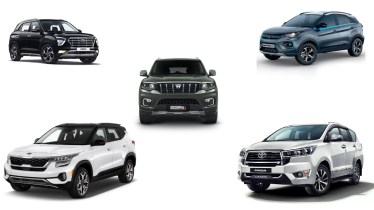The passenger vehicle market is seeing a distinct shift in trend. Gone are the days when customers preferred hatchbacks and buyers are now making a beeline for the SUVs. The craze for it is such that SUVs now command for well over 50 percent share of the passenger vehicle market. Industry experts point out that this shift reflects the evolving consumer preferences and a greater willingness to pay for premium vehicles, given the rising income levels.
In fact, according to data compiled by JATO Dynamics, starting CY2021, the number of SUVs sold in India has surpassed the combined share of sedans and hatchbacks. The share of sedans and hatchbacks have shrunk to 10.32 percent and 30.8 percent in 2022 from 19 percent and 38.37 percent in 2018 respectively.
Looking at the sales data for the first 5 months of 2023 (January to May), the share of sedans has reached 9.22 percent, hatchbacks are at 29.67 percent while SUVs comprise of a whopping 61.11 percent market share. In fact, this is 10 percent higher than the yearly average share of 51 percent for SUVs since 2018.
And if one goes by the trend, the hatchback share is expected to go down further while sedans would still have some appeal in the premium segment.
“There is a growing preference for premium cars. As incomes in India rise, more consumers are able to afford premium cars, such as SUVs and luxury sedans. The key customers for the sedan segment in India are typically young professionals and families. These consumers are looking for a car that is stylish, comfortable and spacious,” explained Ravi Bhatia, President & Director, JATO Dynamics with Financial Express Online.
Evolving customer needs and market maturity
There has been a systematic consolidation in the entry-level market, thanks to stringent government norms, rising raw material prices which have led to many products being discontinued.
On the other hand, the demand for mid-level and premium segment vehicles has been on a categorical rise. In fact, if one looks at the average waiting period for some of the most popular models sold in the country, there are long waiting periods sometime stretching over a year.
“This shift reflects evolving consumer preferences, rising income levels, and a greater willingness to invest in higher-priced vehicles with advanced features and a premium ownership experience. However, entry-level models still hold importance in the market, serving budget-conscious customers and first-time car buyers,” added Bhatia.
In fact, of the 20+ passenger vehicle launches planned for 2023, a majority of them, nearly 13 are SUV-style. This is followed by 4 sedan launches, 2 hatchbacks and 1 microcar.
So is it the end-of-the-line for entry-level cars, especially hatchbacks? The answer is No. While personal vehicle users are maturing towards premium vehicles, there is also an increasing need for shared mobility across the country. This is an area where most entry-level hatchbacks are still finding buyers and demand. If one looks at data for FY2023, of the top 5 passenger vehicles sold in the country, the top 4 models continued to be hatchbacks, albeit seeing some signs of slowdown.
When asked about the outlook for the near future, Bhatia replied, “Challenges such as the transition to EVs and supply chain disruptions may pose hurdles, the industry has opportunities to capitalise on the growing demand for electric mobility, digitalisation, shared mobility, and global export potential. Adapting to changing consumer preferences, embracing technological advancements, and ensuring cost efficiency will be crucial for India Auto Inc in the coming months.”
